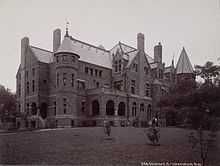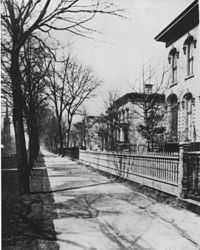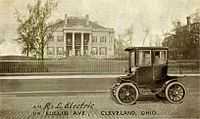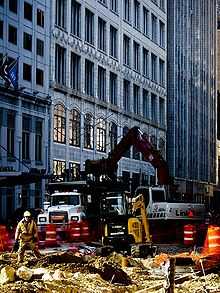Euclid Avenue (Cleveland)

Euclid Avenue is a street in Cleveland, Ohio. It received nationwide attention from the 1860s to the 1920s for its beauty and wealth, including a string of mansions that came to be known as Millionaire's Row. There are several theaters, banks, and churches along Euclid, as well as Cleveland's oldest extant building, the Dunham Tavern. A large reconstruction project, which brought a bus rapid transit line to the street, was completed in 2008.
Euclid Avenue runs from Cleveland to the suburb of Willoughby. It passes through the cities of East Cleveland, Euclid and Wickliffe and forms part of the border between Wickliffe and Willowick. The Cleveland portion of the street begins at Public Square and extends to University Circle. The street passes Playhouse Square, Cleveland State University, the Cleveland Clinic, Severance Hall, Tifereth Israel (The Temple), Case Western Reserve University and University Hospitals Case Medical Center, founded in 1866.
Millionaire's Row


In the second half of the 19th century and early in the 20th century, Euclid Avenue was internationally known. Baedeker's Travel Guides called the elm-lined avenue "The Showplace of America", and designated it as a must see for travelers from Europe. The concentration of wealth was unparalleled; the tax valuation of the mansions along "the Avenue" far exceeded the valuation of New York's Fifth Avenue in the late 19th century. Accounts at the time compared it to the Avenue des Champs-Élysées in Paris and the Unter den Linden in Berlin.[1]
Families living along "Millionaire's Row" included those of John D. Rockefeller (during the period, 1868-84),[2] Sylvester T. Everett, Isaac N. Pennock I (inventor of the first steel railway car in the US), arc light inventor Charles F. Brush, George Worthington, Horace Weddell, Marcus Hanna, Ambrose Swasey, Amasa Stone, John Hay (personal secretary to Abraham Lincoln and Secretary of State under William McKinley), Jeptha Wade (Cleveland benefactor and founder of Western Union Telegraph), Alfred Atmore Pope (iron industrialist and art collector), Worthy S. Streator (railroad baron, coal mine developer, and founder of the city of Streator, Illinois), and Charles Lathrop Pack. Euclid Avenue's most infamous resident was con artist Cassie Chadwick, the wife of Leroy Chadwick, who was unaware that his wife was passing herself off to bankers as the illegitimate daughter of steel magnate Andrew Carnegie.
Architect Charles Schweinfurth designed at least 15 mansions on the street. Samuel Mather's mansion, built around 1910, "was among the last" to be built on Euclid Avenue.[3] The Mather Mansion remains as part of Cleveland State University, but most of the homes were later demolished.

Growth of commercial district and decline of Millionaire's Row
Charles Lathrop Pack is credited with at least part of the development of Euclid Avenue, on which he lived from about 1888 to the early years of the 20th century, into a thriving business district. According to Eyle, "In 1913, an article about Charles reported that 'inside of ten years...the [one-story, commercial buildings that he had developed at the lower end of Euclid Avenue] have disappeared. In their stead are skyscrapers, great retail establishments, magnificent banks, and a hotel that cost $2,000,000. Much of the land is owned by Mr. Pack and is leased for long periods. He helped to organize the companies which erected the buildings. It is said that his rentals, out of which not a penny is subtracted for taxes or anything else, amount to $100,000 a year."[4]
As Cleveland's commercial district began to push eastward along Euclid Avenue, families moved east towards University Circle. However, southeast of University Circle, the topography of the area rises sharply into what is referred to as "The Heights," and the development of Cleveland Heights and Shaker Heights, along with more efficient means of travel, became more attractive than the increasingly commercialized Euclid Avenue.
By the 1920s, the former "Millionaire's Row" was in decline. During the Great Depression, many mansions were converted by their owners into rooming houses, which accelerated the decline. In the 1950s, Cleveland's Innerbelt Freeway cut through the Euclid Avenue neighborhood between downtown and the rail crossing at East 55th Street. By the 1960s, the street that once rivaled Fifth Avenue as the most expensive address in America was a two mile (3 km) long slum of commercial buildings and substandard housing. In the late 1960s, Cleveland Cavaliers owner Nick Mileti announced plans to move the basketball club from Euclid Avenue's Cleveland Arena to a new arena in suburban Richfield Township.
Legacies and redevelopment
Eight houses from the era remain on Euclid, including the Samuel Mather and Howe mansions owned and used by Cleveland State University. The most recent to be demolished was the Lyman Treadway Mansion, which served as part of the Cleveland Museum of Health from the 1930s until it was razed in 2002 for a new museum building.
The Euclid Avenue Historic District is listed on the National Register of Historic Places.
On August 5, 1914, the American Traffic Signal Company installed a traffic signal system on the corner of East 105th Street and Euclid Avenue, the first traffic light installed in the United States.
Theaters of Playhouse Square
In their 1949 musical South Pacific, Rodgers and Hammerstein indirectly acknowledged the street's fame. In the script, Captain Brackett sends a grass skirt to one "Amelia Fortuna, 325 Euclid Avenue, Shaker Heights, Cleveland, Ohio". Theaters on Euclid include the Allen Theatre, State Theatre, Ohio Theatre, and Palace Theater.
Recent events

In April 2006, parts of Euclid Avenue were closed to traffic for the filming of a scene from the film Spider-Man 3. No major stars were on location, but the filming drew thousands of gawkers. Most of the filming involved explosions and destroyed cars, with hired extras walking the sidewalks. The sections of the street that were closed off were redressed to resemble a city street in New York City, complete with magazine stands and poster-covered walls.[5]
The Greater Cleveland Regional Transit Authority completely refurbished the western section of Euclid Avenue as part of the Euclid Corridor Transportation Project, which opened fully in 2008. A bus rapid transit line, the HealthLine, now runs from Public Square to the Stokes Rapid Transit station in East Cleveland, which is the eastern terminus of the Red Line rapid transit route. The refurbishing also entailed development – as of November 2009, more than $3.3 billion worth of completed or proposed urban renewal projects lined the street and surrounding area.[6]
Route designations
Euclid Avenue, originally known as part of the Buffalo Stage Road,[7] has carried various route designations throughout history:[8]
- 1923–1925: State Route 2 from Willoughby to Mayfield Road and State Route 2/State Route 15 from Mayfield Road to Public Square in Cleveland
- 1926: SR 2 from Willoughby to Superior Ave., and SR 15 from Mayfield Rd. to Public Square
- 1926–1931: U.S. Route 20 from Willoughby to Superior Ave., and U.S. Route 322 from Mayfield Rd. to Public Square
- 1932–1935: U.S. Route 6/U.S. Route 20 from Willoughby to Superior Ave., and U.S. Route 322 from Mayfield Rd. to Public Square
- 1936–1949: US 6/US 20 from Willoughby to Superior Ave., U.S. Route 6 Alternate/U.S. Route 20 Alternate from Superior Ave. to Mayfield Rd., and US 322/Alt. US 6/Alt. US 20 from Mayfield Rd. to Public Square
- 1950–1966: US 6/US 20 from Willoughby to Superior Ave., and Alt. US 6/Alt. US 20 from Superior Ave. to Public Square (US 322/Alt. US 6/Alt. US 20 from Mayfield Rd. to Chester Ave.)
- Since 1967: US 20 from Willoughby to Public Square (US 20/US 322 from Mayfield Rd. to Chester Ave.)
Landmarks on Euclid
Public Square
- 200 Public Square Building (1982-1986)
- Soldiers and Sailors Monument (1894 renovated 2008-2010)
East 4th Street Culinary District
- Cleveland Arcade 1890
- 5th Street Arcades - 530 Euclid Avenue
- 1040 Woodview Road
- PNC Bank Garfield Building 1890
East Ninth Financial District
- Ameritrust Tower Now the Nine Complex of the Nine Apartments and Metropolitan Hotel 2014
- City Club of Cleveland
- PNC Tower 1977-80
- Cleveland Trust Company headquarters building 1908 Now a Heinen's Grocery Store Opened February 25, 2015.
- Huntington Bank Building 1922-24
- 1010 Euclid
East 12th
- Statler Arms Apartments
- Union Club
- Halle Building (studios for CBS Radio stations WNCX and WKRK; exterior was used on The Drew Carey Show)
- Sterling Linder
East 14th St./Playhouse Square
- The ideastream Idea Center (studios for PBS affiliate WVIZ, NPR affiliate WCPN, and classical music WCLV)
- Wyndham Hotel
- Renaissance/USBank Tower
- GE Chandelier, world's largest outdoor chandelier[9][10]
- Hanna Theatre
- Allen Theatre
- Ohio Theatre
- State Theatre
- Palace Theater
- Keith Building
East 17th-East 24th St. Cleveland State University Campus
- Cleveland-Marshall College of Law
- CSU Levin College for Urban Affairs
- CSU Music School
- CSU Student Center
- CSU Main Library/Rhoades Tower
- Main Classrooms
- CSU Science
- Fenn College of Engineering
- Viking Hall
- Fenn Tower
- Trinity Cathedral
Innerbelt
East 30th St.
- WEWS-TV
- Cuyahoga Board of Elections
- Applied Industrial Technologies
- Karpinski Engineering
Midtown East 55th St.
- Cleveland Agora
- University Hospitals of Cleveland
- Cleveland Clinic Campus
- University Circle
- East Cleveland, Ohio
- Euclid, Ohio
- Wickliffe, Ohio
- Center For Pastoral Leadership (Catholic Diocese of Cleveland Seminaries)
See also
References
- Eyle, Alexandra. 1992. Charles Lathrop Pack: Timberman, Forest Conservationist, and Pioneer in Forest Education. Syracuse, NY: ESF College Foundation, Inc., and College of Environmental Science and Forestry. Distributed by Syracuse University Press. Available: books
- Wilson, Ella G. 1932. Famous Old Euclid Ave. Cleveland.
Notes
- ↑ Theiss, Evelyn (2011-04-03). "The Stockbridge in Cleveland has been sitting proudly on Euclid since the days of Millionaires' Row". The Plain Dealer. Retrieved 2011-04-05.
- ↑ 2.0 2.1 Eyle, p. 39
- ↑ Eyle, p. 40
- ↑ Morrow, James B. January 5, 1913. "No sentiment, just plain common sense made him the first active worker for forest conservation," Sunday Plain Dealer, editorial and drama section. Quoted in Eyle, p. 40
- ↑ Ewinger, James (2006-04-17). "Spidey's web to make Euclid Ave., E. 9th sticky". The Plain Dealer. Retrieved 2009-07-01.
- ↑ Jarboe, Michelle (2009-11-29). "Cleveland's Euclid corridor project has paved the way to economic development". The Plain Dealer. Retrieved 2009-11-30.
- ↑ DeMarco, Laura (2009-07-27). "More on Cleveland walking tours and history". The Plain Dealer. Retrieved 2009-08-02.
- ↑ Official Transportation Map archive, Ohio Department of Transportation
- ↑ Cindi, Szymanski (January 14, 2014). "PlayhouseSquare Announces GE Lighting as Major Supporter of Neighborhood Transformation and Exclusive Chandelier Sponsor" (Press release). PlayhouseSquare. Retrieved May 3, 2014.
- ↑ Simakis, Andrea (May 2, 2014). "Chandelierious! Dazzle the District Lights the Way to New Era for Playhouse Square". The Plain Dealer. Retrieved May 3, 2014.
Further reading
Cigliano, Jan (1991). Showplace of America: Cleveland's Euclid Avenue, 1850-1910. Kent, Ohio: Kent State University Press. ISBN 0-87338-445-8.
External links
| Wikimedia Commons has media related to Euclid Avenue. |
- Euclid Ave. from The Encyclopedia of Cleveland History
- Euclid Avenue Memories, Plain Dealer special section, June 19, 2006.
- "Euclid Corridor project helps drive $4 billion in Cleveland development" by Steven Litt, The Plain Dealer, February 10, 2008. Includes video.
Coordinates: 41°30′14″N 81°36′42″W / 41.504007°N 81.611555°W